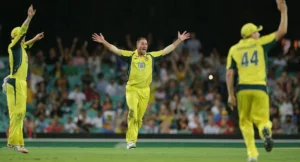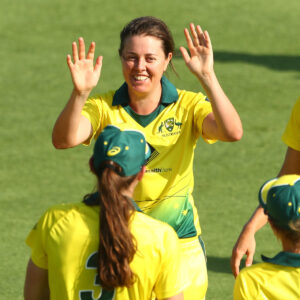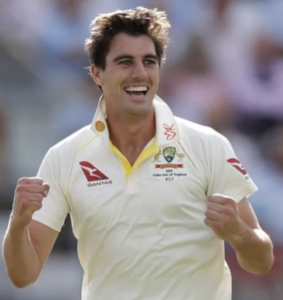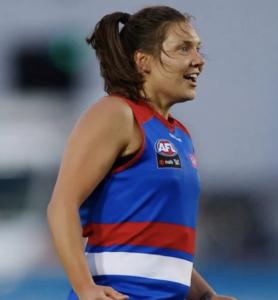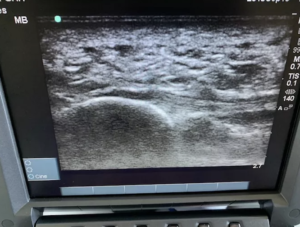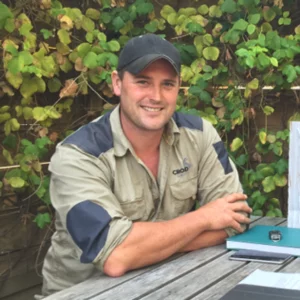
by Sam Davies
Molly Strano is the all-time leading wicket taker in the Women’s Big Bash League, and a member of the Australia’s World Cup winning team in 2020. Molly sat down with our podiatrist, Sam Davies to talk all things from elite sports training and stress fracture rehabilitation, to dancing with Katy Perry.
Sam: Thanks for giving up your time to chat with us today, Molly. I just wanted to start by talking about when you first came into the Victorian Cricket team, when you were only 16 years old. You were chosen as an opening batter, which seems odd as we all know you as the all-time leading wicket taker in the Big Bash League. How did that big change from batter to bowler come about?
Molly: Good question. I’m a late bloomer in the bowling department. I was rookie-contracted to Victoria as an opening batter but at the time there were five or six Australian batters in that team. It was always going to be hard for me to break into that playing XI as a batter.
I bowled some very very ‘part-time’ off-spin at the time and had a coach who sat me down during an end-of-season review. She gave me some sage advice and told me to start taking my off-breaks a bit more seriously because that will be your avenue into the team. (And) the batting approach may take lot longer to chip away at. I took that advice on board and went ‘all-in’ and really started to take my bowling seriously.
I felt like that change happened quickly. I was very raw and was very lucky to be gifted some opportunities as an inexperienced, young off-spinner to hone my craft at State level. And to slowly transition into becoming one of the main spinners alongside Kristen Beams at Victoria.
So, it eventuated like that. With the coach telling me to put my batting on the backburner and take your spin more seriously. It happened quickly and I really enjoyed the craft, which made me want to keep working and working at it. I’m twenty-nine now but I still feel like I’m forever learning, forever chipping away, and trying to improve.
That’s the beauty of cricket nowadays, and especially with the women’s game evolving so quickly that you have to keep adding new tricks if you want to keep up with the pack.
SD: Incredible. Then I imagine training would have to be completely different. Going from heavily batting orientated sessions, to then having to transition to bowling focused. It would have been a big change for your body to get used to.
MS: Yeah, massively! And this led to my body breaking down in a way, when I was in my early twenties with that change in skill set, and the big change in my training regime.
As a youngster growing up, I spent a lot of time in the nets hitting balls. Not necessarily bowling them. Then that changed when I was eighteen or nineteen when the look of my training changed quite dramatically. For instance, the first thing to do when you rock up to training as a bowler is to head straight into the bowling rotation, which tends to be longer, and you only have shorter hit at the end.
So, I think I was twenty-one or twenty-two when I sustained a stress fracture in my back. That was probably testament to me not having that load as a youngster and then suddenly jumping into the deep-end. Also, as a spinner your training loads are quite high and back then the sport science around load management wasn’t as advanced as it is now. So, it was a massive shock to the system and sustained the injury as a result.

SD: Stress fractures in the back. It has almost become a cricketer’s curse hasn’t it? In terms of the high numbers we hear about.
MS: Yeah, it’s usually a fast bowler’s injury so very rare for a spinner to suffer a stress fracture. I’m pretty confident the reason for it was because I didn’t have that loading as a youngster. I didn’t bowl a massive amount of overs as a kid, and then jumped straight into the deep end. Definitely not a common injury for a little off-spinner like myself. More of a ‘fast bowlers curse.’
But it [the injury] was a good learning curve in a way as it made me manage my body better and look after myself as well.
SD: How long were you ruled out from cricket with the stress fracture?
MS: I was out for about four months, which is on the shorter side for recovery for such an injury. I was over in the UK playing and not only was I new to the bowling realm, but I also had back-to-back seasons. I had an Australian summer and then an English summer as well. Two cricket seasons back-to-back without a break.
When I was in the UK I started to get a bit of a sore back and then it progressively got worse, to the point where I just couldn’t bowl. I wasn’t sure if it was okay or that was just the norm given the average bowler’s back. It was pretty bad.
I rushed back to Melbourne and got a scan in early September, which meant I missed a few 50-over games for Victoria. But I managed to sneak back in time for the Big Bash, which started mid-December. That was the first edition of the Big Bash.
My recovery went pretty smoothly, and I was able to get back fairly quickly. All in all, I was out for a few months.
SD: Lots of rest to manage the stress fracture or did you have an intense rehab program?
MS: Early on, it’s pretty much complete rest. From there you are slowly reintroduced to running, gym and all that sort of stuff. The frustrating thing with stress fractures is that after one month I felt good as gold. I wanted to get back bowling but had to be very cautious because the last thing you want is for the fracture to become more serious and impact your recovery and turn into a five-to-six-month injury.
But at the time, after about one-month things have settled and it feels okay, you feel ready and raring to go. I had to be constantly held back by our physio. I did a lot of time on the bike and had a slow build-up back to bowling. I also had to restructure the way I was delivering the ball and work on my bowling action just to make it a bit safer. I did a lot of work with the coach of Cricket Victoria, Tim McCaskill who helped me tinker with my action so that I would return to bowling in a far safer fashion and not do the same injury in the future. Touch wood, I haven’t had any issues with my back since.
SD: Fantastic to hear. Now steering away from your injury, we get a lot of families at our clinic where the weekend is ‘chock-full’ of junior sports. Last week I was watching Youtube vision of Essendon Maribyrnong Park Ladies Cricket Club awarding you lifetime membership. The look of pride on your dad’s face during it would resonate with a lot of the parents we see. Did your parents take you all over the country to play junior sport?
MS: My parents were phenomenal. Also, my Nan put in some massive shifts to help me get around. Especially with cricket because they are very long days. Probably a parent’s nightmare.
When I was younger, I was playing junior cricket in the morning. Very early start, usually 7am to midday and then they’d rush me out to play senior women’s in the afternoon, which would usually be 1:30pm to 6 o’clock. So, my parent put in some proper big shifts, and I owe them a lot. I will be forever grateful for some of those car rides that they have had to endure. They have been phenomenal support to me, and I remember that video because on the night my dad got super emotional when I was awarded life membership. It meant a lot to them and a lot to me as I had been at my club for fifteen years. My club has been huge in my development, not just as a cricketer but as a person as well. I’ve learnt a lot of life lessons there. It was a real honour and something I’ll be super proud of for the rest of my life. To be on the honour board and to be dubbed a life member of the Essendon Maribyrnong Park.
SD: Speaking of back-to-back games and training sessions, I’ve always been curious how cricketers adapt to the varying formats. From 20 over cricket, to 50 over cricket, and then to red ball matches. Is it hard adjusting to the changing conditions?
MS: Yeah, as a female domestic player it’s probably a little bit easier than for a male domestic player because we don’t play any red ball cricket. We’ve really only got the two formats with T20 and 50-over cricket. From a bowling-load perspective, it’s either four overs in a match or ten overs, so it’s not a big difference.
You definitely do feel it after playing a lot of T20 cricket and going back to 50-over cricket where you have to field for three hours compared to seventy-five minutes. That’s the real battle. Customising yourself to being in the field for longer.
I don’t find the transition too different from a bowling point of view. In 50-over cricket I’m used to bowling in the ‘Power Play’ or at the death [back-end of the innings], which is a similar role I play in T20 cricket. The skills are transferable and for me I don’t think it changes my training or the skills I’m trying to execute.
From a female cricket point of view, it’s probably not too hard to jump between the two formats. Whereas for an example, I could imagine that for the Tassie Tiger boys preparing for a Shield match and then swapping into the Big Bash would be a bit tricky.

Credit: Photo courtesy of Australian Women’s Cricket
SD: Molly, between your time at the Melbourne Renegades and now at the Hobart Hurricanes you have played 99 Big Bash games and have taken 119 wickets. You are the all-time highest wicket taker in the competition. What do you owe that level of consistency to?
MS: It’s really hard to pinpoint. Sometimes I have to pinch myself to think that I’ve played 99 games of Big Bash cricket. And that my first game next season I’ll be running through the 100-game banner per se. Not an actual banner, but being an AFL fan, we all know that’s usually the case. To think I’ve notched up 100 games I really do have to pinch myself.
But I don’t know [what I owe the consistency to]. I love my training and I’m really passionate about it. I love the feeling of trying to improve and evolve my game. So, I think that helps me with my consistency. I’m pretty thorough in the way that I review my season and then at the beginning of preseason I set out clear things I want to work on, which I believe will help me when it comes to the WBBL.
Each year the women’s game goes from strength to strength. There are going to be girls that come out swinging this year and hit the ball incredibly hard, so I’ve got to work out ways to nullify their impact.
I work closely down here in Tassie with Dan Marsh who is my batting and bowling coach. Day one of each preseason, Marshy and I sit down and figure out what we need to work on this year. Not just to help me improve but also what I need to do to help the Hurricanes be successful in the WBBL, being one of the lead spin bowlers in the team. So, I’ll sit down with Marshy and work out the plan of attack as to what my training is going to look like and what skills I’ll try to refine. But as I said, I’m passionate about improving and trying to evolve my game. Got to keep up with the pack and the young kids that are coming through, who are incredibly talented. Dan Marsh plays a big part in that and is an important person in my cricket development. I lean on him quite heavily in that space.
SD: Given that intense scrutiny of your game and trying to improve all the time, in off-season do you pick-up a cricket ball. Or do you try and keep your mind right off the game?
MS: As I’ve gotten older, I literally do not touch a bat or ball over the six-week break. I think it’s really important for me to drop the tools because as a person I have the tendency to overtrain. Once we start preseason [first week of June] they usually have to put a few restrictions on me as I could spend all day, everyday in the nets. So, I make a conscious effort over that six-week period not to touch bat or ball.
However, I do love my health and fitness so over the off-season it’s really nice for me to just be able to go out and do some leisure activity, which you don’t have the time nor energy to do during cricket season. I spend a lot of time on my mountain bike and explored some really good trails here in Tassie, which has been nice. I love my running as well, so I’ll go for some longer ones with the headphones in. Listen to some good music and enjoy the beautiful views along the eastern shore waterfront here in Hobart. It’s been great to drop the tools and do casual exercise that’s not prescribed or regimented as it will be come the start of preseason. Having said that I’m definitely excited for preseason because I love to train and the physical aspect of it. A few of my mates will screw their noses up at that but I just love it.
SD: I find it incredible that you start preseason in June, for what is technically a summer sport.
MS: I feel like preseason starts earlier and earlier every year. Or maybe I’m just getting older.
Our first game will most likely be towards the end of September, which will be some 50-over cricket for Tassie. That’ll be before we break out into Big Bash mode, which usually starts mid-October. So, we will prepare ourselves for the 50-over format first and then after a couple of games we go our separate ways into our Big Bash teams.
SD: Like many, I’ve sat down and watched ‘The Record’ on Amazon Prime. The documentary following the Australian Women’s Cricket Team during the 2020 ICC T20 World Cup. You were a late call up into the side due to some injuries. What was it like to be given the ball to bowl the first over for Australia in the World Cup?
MS: Yeah, the cricket season was done at that point. So, when I got the call to say that I wasn’t in the T20 squad, I firmly put my cricket bag away, locked it up. I was done for the year. But then I had to quickly go and dust it off again because I got a phone call two days out before the first game to tell me someone had gone down with an injury,and that I was going to get parachuted into the squad for the entirety of the World Cup.
It was a shock to the system, both emotionally and physically. I think I had already thrown my spikes out, so I had to instantly rush around and find a new pair. That’s because at the end of every cricket season, the first thing I do is to throw out the spikes that have served me well during the year. It was an absolute mad rush but such a phenomenal experience.
I’d never played in a World Cup before so to have the ball in my hand, opening the bowling in Game One for my country was a phenomenal moment. I had to pinch myself and thought, “What am I actually doing here?”
That whole World Cup was a rollercoaster of emotions. We [Australia] almost didn’t progress through the Group Stage because we lost our first game and didn’t play that well in Game Two. We snuck our way through to the Semi-Finals, which was rain-affected but managed to win against South Africa via the Duckworth-Lewis system. We then had our Final on the MCG where we put our best game together on the big stage. The girls were super dominant on the day and won pretty easily. It was an awesome experience and something I’ll never forget. I already can’t wait for all the reunions. The five-year reunion, the ten-year reunion, the fifteen-year reunion. It was just a great time in our lives.

Credit: Photo courtesy of Australian Women’s Cricket
SD: 86,174 people were at the Final watching on, which is a massive number. I don’t think we can do an interview with Molly Strano without bringing up the World Cup celebrations. After the Final, international popstar, Katy Perry performed on stage. I have it on good authority that you somehow ended up with her shoes. Do you still have them?
MS: The Katy Perry shoes are in Melbourne, taking pride of place at my mum and dad’s house. They didn’t make the trek across the Bass Strait. Probably for good reason as well because I still can’t believe I didn’t roll both of my ankles wearing those around. They are a danger and hazard, so I thought it was best for everyone including my employers at Cricket Tasmania that I leave them back in Melbourne.
I’ll definitely be keeping them though for a very long time. Every time I see them, they bring back some great memories.
SD: So, being a podiatry interview, you are saying that the Katy Perry shoes don’t provide the appropriate levels of support?
MS: No, not great ankle support. And we know pointed toed, high-heels screams danger. I probably won’t be wearing them ever again. I’ll look at the shoes from afar and admire them because they did cause a bit of damage.
SD: Fantastic take home message for everyone regarding footwear. Now just to finish we have 3 quick-fire questions.
- Usual pregame meal?
MS: Good question. Back in the day when I was living in Melbourne my favourite and trusty pregame meal would be your humble spaghetti bolognese. Being Italian my favourite interpretation of the spaghetti bolognese would be my Nonna’s version, where she makes homemade sauce and homemade pasta. So, that’s me being very fussy. But any sort of spag-bol probably fuels me the best and gives me a good way to fill the tank before a long day of cricket.
2. You are hosting a dinner party for three people. It can be any three people from any time. Who are you inviting?
MS: This is a really hard question. Now that I’m not based in Melbourne my next-door neighbour used to be Mel Jones [former Australian cricketer and commentator on Fox]. She lives in Sydney and goes all over the world doing the commentary circuit. She’s in England as we speak. Mel is now my number one dream dinner guest because we just don’t get to spend time with each other anymore. She gets an invite just to catch-up on lost time.
Who else? As a kid I used to love Adam Gilchrist [former Australian vice-captain]. So, I’d definitely invite “Gilly.” I used to adore him when I was growing up. I loved the way he went about his cricket, trying to whack everyone out of the attack. Gilly gets the number two spot as my dream dinner guest.
Let’s continue with the cricket theme and from an opposition perspective I used to love watching Graeme Swann. This was when I was just starting to bowl spin, I remember England had come over here and won the Ashes in 2010 and he led the charge. Very much a character. I remember when they [England] had won at the MCG he was doing the “sprinkler” dance moves and just being outrageous. Something about Graeme Swann I connected with. Not only from a bowling perspective but also with him being a bit of a ratbag. So, he rounds out my three dinner guests. Jonesy, Gilly, and Graeme Swann.
SD: Right so those yellow sunnies to wore on stage with Katy Perry, they were Graeme Swan inspired?
MS: I probably did the “sprinkler” on stage too, which was paying direct homage to Graeme Swann as well.
3. And finally, if you didn’t take up cricket what would you be doing?
MS: When I was younger, I used to play soccer as well. So, in the winter I’d play soccer and then in the summer I’d play cricket. If it wasn’t for cricket, I’d be playing soccer. I’d probably be playing soccer now but due to contracts you’re not allowed to partake in any other sport. I remember talking to our high-performance manager at the end of the season, asking him if I could play soccer this winter in Tassie because I’m on a friend-finding mission. Tried to package the argument that way. “I need to make friends, Simon. Please let me play.” So, definitely would have thrown my all at soccer and give that a bit of a nudge as well, as that was my second favourite sport when growing up.
SD: Thanks a lot for talking with us today, Molly. I really appreciate you taking the time.
MS: My pleasure. It’s been good to chat.

